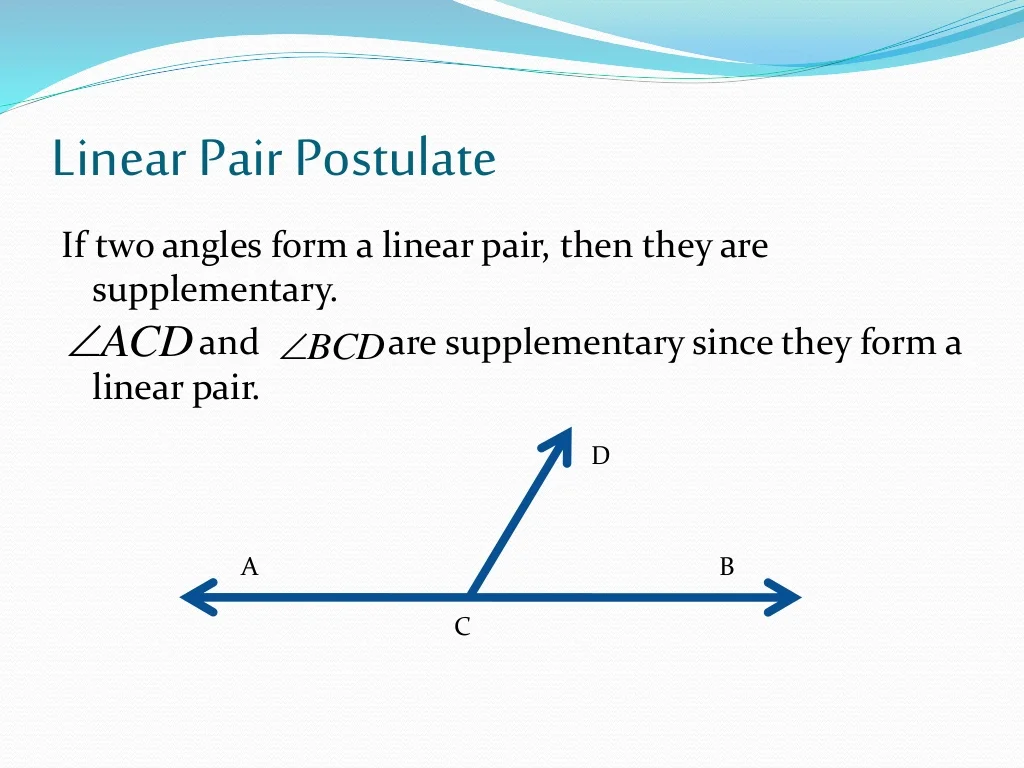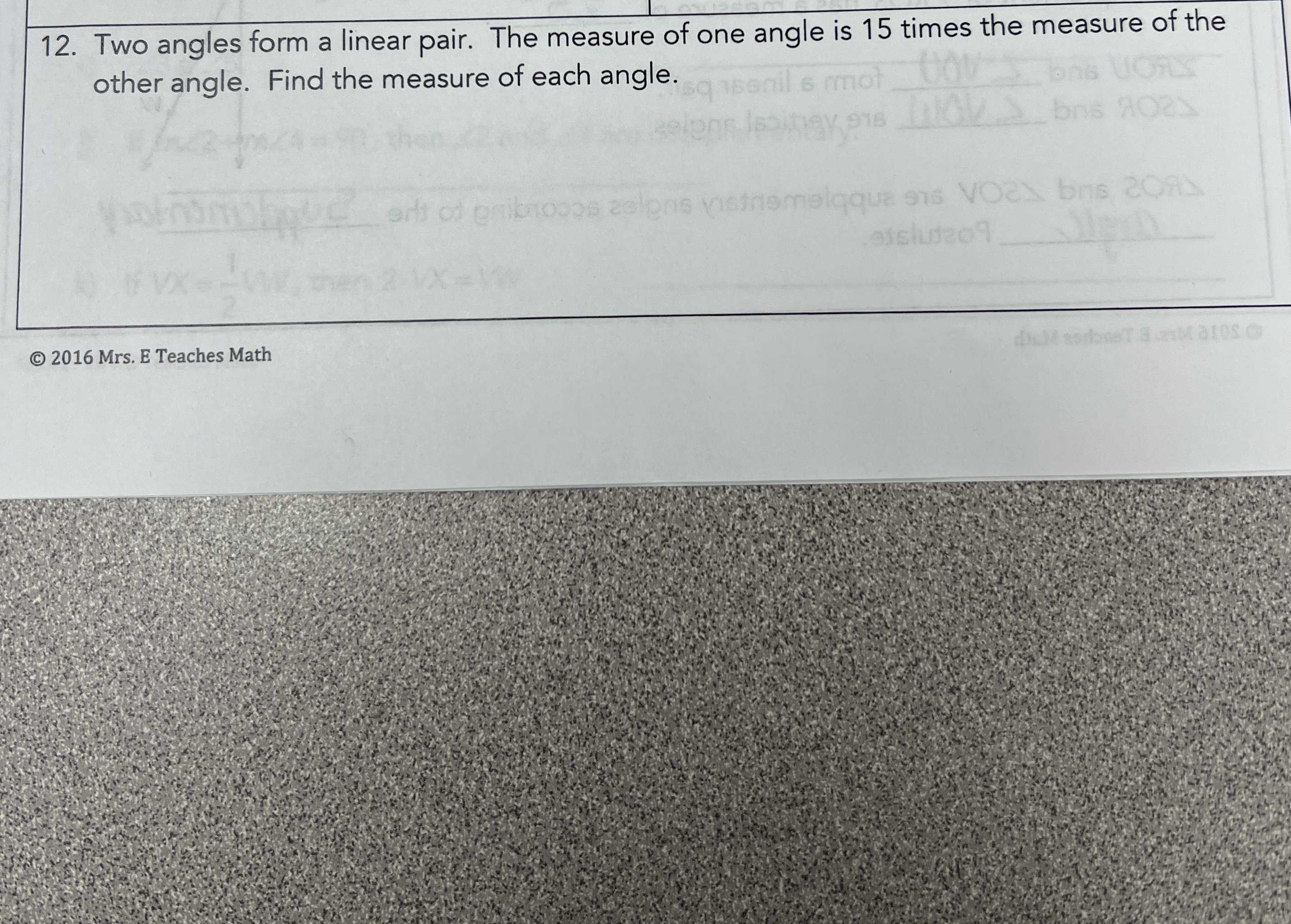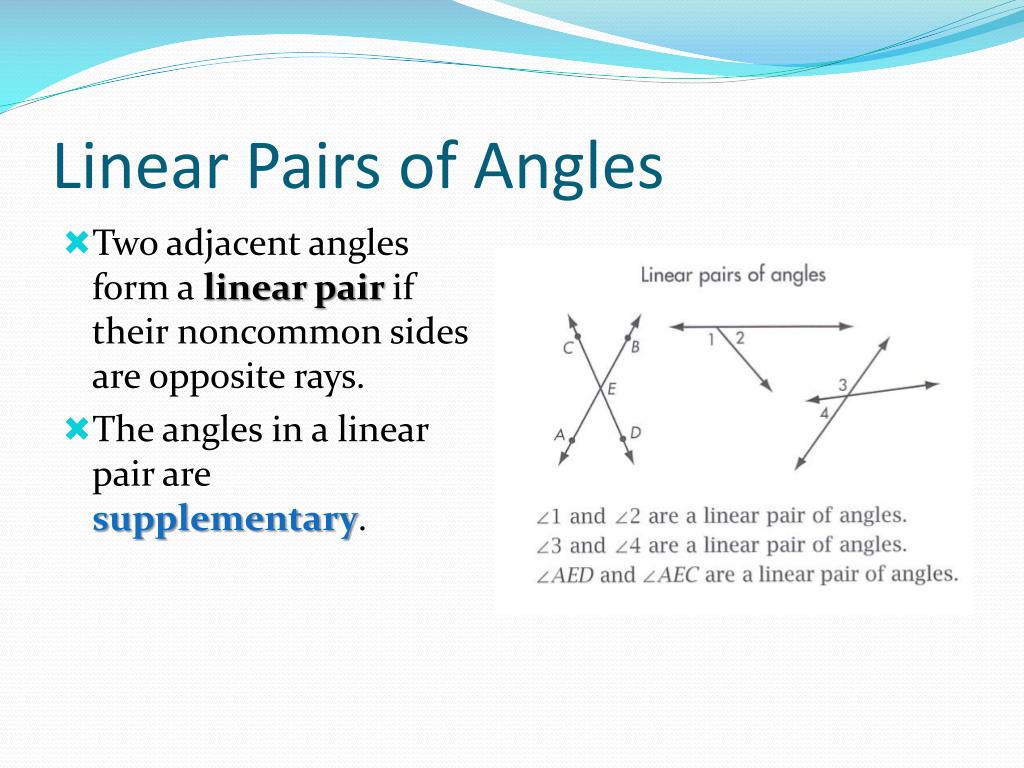Two Angles Form A Linear Pair
Two Angles Form A Linear Pair - In the figure, ∠ 1 and ∠ 2 form a linear pair. X + 1/3x = 180. In the figure, ∠ 1 and ∠ 2 are supplementary by the. The sum of two angles in the linear pair is always 180 degrees. Linear pairs are adjacent angles who share a common ray and whose opposite rays. Web which statements are true regarding undefinable terms in geometry? Web however, just because two angles are supplementary does not mean they form a linear pair. A point's location on the coordinate plane is indicated by an ordered pair,. So that means <1 + <2 =180 but let’s call those. If we merge the two angles, they will form a larger angle, \angle.
Web however, just because two angles are supplementary does not mean they form a linear pair. (i) angles forming a linear pair are supplementary. Web in math, the linear pair postulate or linear pair theorem, says the same in mathematical terms. Linear pairs are adjacent angles who share a common ray and whose opposite rays. Web up to 6% cash back the supplement postulate states that if two angles form a linear pair , then they are supplementary. The sum of two angles in the linear pair is always 180 degrees. So do ∠ 2 and ∠ 3 , ∠ 3 and ∠ 4 , and. Web first we need to define what is a linear pair? Web there are some properties of linear pair of angles and they are listed below: So that means <1 + <2 =180 but let’s call those.
A line is 180 degrees. Supplementary angles are two angles whose same is 180o. Web 4.9 (928) retired math prof. A linear pair are two angles that makes a line. Web which statements are true regarding undefinable terms in geometry? The measure of one angle is 1/3 the measure of the other angle. So that means <1 + <2 =180 but let’s call those. It should be noted that all linear pairs are supplementary because. X + 1/3x = 180. X = measure of one angle.
Linear pair
Web however, just because two angles are supplementary does not mean they form a linear pair. (i) angles forming a linear pair are supplementary. Web there are some properties of linear pair of angles and they are listed below: In the figure, ∠ 1 and ∠ 2 form a linear pair. Linear pairs are adjacent angles who share a common.
Two angles form a linear pair. The measure of one CameraMath
Web first we need to define what is a linear pair? Web the smaller angle measures the larger angle measures 2)two angles form a linear pair. Linear pairs are adjacent angles who share a common ray and whose opposite rays. The sum of linear pairs is 180°. If two angles forms a linear pair, this means that the sum of.
Which statement is true about this argument? Premises If two angles
Web the smaller angle measures the larger angle measures 2)two angles form a linear pair. Web which statements are true regarding undefinable terms in geometry? Web however, just because two angles are supplementary does not mean they form a linear pair. Web 4.9 (928) retired math prof. Web determine whether each pair of angles can form a linear pair of.
The two angles below form a linear pair, and the expressions are
In the figure, ∠ 1 and ∠ 2 are supplementary by the. X + 1/3x = 180. Linear pairs are adjacent angles who share a common ray and whose opposite rays. Supplementary angles are two angles whose same is 180o. If two angles form a linear pair, then the sum of the degree measures of the angles.
Definition and Examples of Linear Pairs YouTube
A point's location on the coordinate plane is indicated by an ordered pair,. Web in math, the linear pair postulate or linear pair theorem, says the same in mathematical terms. Web which statements are true regarding undefinable terms in geometry? Web the two angles make a linear pair, so the sum of measures of the two angles is 180°\text{\textdegree}°. The.
Name two angles that form a linear pair.
If we merge the two angles, they will form a larger angle, \angle. Web up to 6% cash back the supplement postulate states that if two angles form a linear pair , then they are supplementary. The measure of one angle is 1/3 the measure of the other angle. Web in math, the linear pair postulate or linear pair theorem,.
📈In which diagram do angles 1 and 2 form a linear pair?
Web determine whether each pair of angles can form a linear pair of angles when combined. Web two angles forming a linear pair, their measurements add up to 180. Web the two angles make a linear pair, so the sum of measures of the two angles is 180°\text{\textdegree}°. Web 4.9 (928) retired math prof. Web in math, the linear pair.
PPT Geometry Review Angles and Parallel Lines PowerPoint Presentation
Web in math, the linear pair postulate or linear pair theorem, says the same in mathematical terms. So that means <1 + <2 =180 but let’s call those. If two angles form a linear pair, then the sum of the degree measures of the angles. Web the smaller angle measures the larger angle measures 2)two angles form a linear pair..
Linear pair
X + 1/3x = 180. 1/3 x = measure of other angle. So that means <1 + <2 =180 but let’s call those. X = measure of one angle. A linear pair are two angles that makes a line.
Linear Pair lines and angles This postulate is sometimes call the
Web up to 6% cash back a linear pair is a pair of adjacent angles formed when two lines intersect. Linear pairs are adjacent angles who share a common ray and whose opposite rays. In the diagram below, ∠abc and ∠dbe are supplementary since 30°+150°=180°,. It should be noted that all linear pairs are supplementary because. Web which statements are.
So Do ∠ 2 And ∠ 3 , ∠ 3 And ∠ 4 , And.
Web determine whether each pair of angles can form a linear pair of angles when combined. Web which of the following statements are true., (t) and which are false (f)? X + 1/3x = 180. If two angles forms a linear pair, this means that the sum of the angles is 180°.
Web The Two Angles Make A Linear Pair, So The Sum Of Measures Of The Two Angles Is 180°\Text{\Textdegree}°.
A linear pair are two angles that makes a line. (ii) if two adjacent angles are equal, then each angle. Linear pairs are adjacent angles who share a common ray and whose opposite rays. In the diagram below, ∠abc and ∠dbe are supplementary since 30°+150°=180°,.
1/3 X = Measure Of Other Angle.
Web first we need to define what is a linear pair? Web up to 6% cash back a linear pair is a pair of adjacent angles formed when two lines intersect. The sum of linear pairs is 180°. X = measure of one angle.
Web 4.9 (928) Retired Math Prof.
(i) angles forming a linear pair are supplementary. Web the smaller angle measures the larger angle measures 2)two angles form a linear pair. Supplementary angles are two angles whose same is 180o. If we merge the two angles, they will form a larger angle, \angle.









